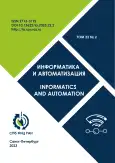Vol 22, No 2 (2023)
Digital information telecommunication technologies
Limit Bipolar Sequences for Patchwork-Based Robust Digital Audio Watermarking
Abstract
 221-260
221-260


Noise Immunity of Single-Sideband Modulation Signals with a Controlled Carrier Level
Abstract
 261-288
261-288


Building a Chatbot System to Analyze Opinions of English Comments
Abstract
Chatbot research has advanced significantly over the years. Enterprises have been investigating how to improve these tools’ performance, adoption, and implementation to communicate with customers or internal teams through social media. Besides, businesses also want to pay attention to quality reviews from customers via social networks about products available in the market. From there, please select a new method to improve the service quality of their products and then send it to publishing agencies to publish based on the needs and evaluation of society. Although there have been numerous recent studies, not all of them address the issue of opinion evaluation on the chatbot system. The primary goal of this paper’s research is to evaluate human comments in English via the chatbot system. The system’s documents are preprocessed and opinion-matched to provide opinion judgments based on English comments. Based on practical needs and social conditions, this methodology aims to evolve chatbot content based on user inter-actions, allowing for a cyclic and human-supervised process with the following steps to evaluate comments in English. First, we preprocess the input data by collecting social media comments, and then our system parses those comments according to the rating views for each topic covered. Finally, our system will give a rating and comment result for each comment entered into the system. Experiments show that our method can improve accuracy better than the referenced methods by 78.53%.
 289-315
289-315


Performance Analysis of Concatenated Coding to Increase the Endurance of Multilevel NAND Flash Memory
Abstract
 316-348
316-348


Mathematical modeling and applied mathematics
Properties Investigation of Self-Dual Combinational Devices with Calculation Control Based on Hamming Codes
Abstract
 349-392
349-392


Optimization of the Regression Ensemble Size
Abstract
Ensemble learning algorithms such as bagging often generate unnecessarily large models, which consume extra computational resources and may degrade the generalization ability. Pruning can potentially reduce ensemble size as well as improve performance; however, researchers have previously focused more on pruning classifiers rather than regressors. This is because, in general, ensemble pruning is based on two metrics: diversity and accuracy. Many diversity metrics are known for problems dealing with a finite set of classes defined by discrete labels. Therefore, most of the work on ensemble pruning is focused on such problems: classification, clustering, and feature selection. For the regression problem, it is much more difficult to introduce a diversity metric. In fact, the only such metric known to date is a correlation matrix based on regressor predictions. This study seeks to address this gap. First, we introduce the mathematical condition that allows checking whether the regression ensemble includes redundant estimators, i.e., estimators, whose removal improves the ensemble performance. Developing this approach, we propose a new ambiguity-based pruning (AP) algorithm that bases on error-ambiguity decomposition formulated for a regression problem. To check the quality of AP, we compare it with the two methods that directly minimize the error by sequentially including and excluding regressors, as well as with the state-of-art Ordered Aggregation algorithm. Experimental studies confirm that the proposed approach allows reducing the size of the regression ensemble with simultaneous improvement in its performance and surpasses all compared methods.
 393-415
393-415


Discovery of Economic Collusion by Metrics of Quantum Entanglement
Abstract
 416-446
416-446


Position Correction Algorithm of Well Pads When Solving the Problem of Developing Oil Fields
Abstract
 447-481
447-481











